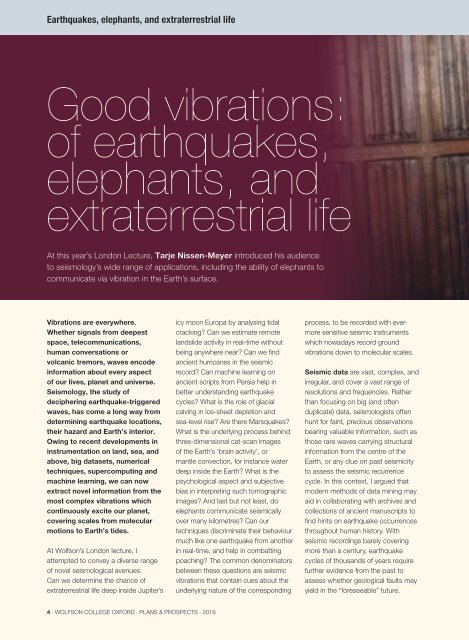Create successful ePaper yourself
Turn your PDF publications into a flip-book with our unique Google optimized e-Paper software.
Earthquakes, elephants, and extraterrestrial life<br />
Good vibrations:<br />
of earthquakes,<br />
elephants, and<br />
extraterrestrial life<br />
At this year’s London Lecture, Tarje Nissen-Meyer introduced his audience<br />
to seismology’s wide range of applications, including the ability of elephants to<br />
communicate via vibration in the Earth’s surface.<br />
Vibrations are everywhere.<br />
Whether signals from deepest<br />
space, telecommunications,<br />
human conversations or<br />
volcanic tremors, waves encode<br />
information about every aspect<br />
of our lives, planet and universe.<br />
Seismology, the study of<br />
deciphering earthquake-triggered<br />
waves, has come a long way from<br />
determining earthquake locations,<br />
their hazard and Earth’s interior.<br />
Owing to recent developments in<br />
instrumentation on land, sea, and<br />
above, big datasets, numerical<br />
techniques, supercomputing and<br />
machine learning, we can now<br />
extract novel information from the<br />
most complex vibrations which<br />
continuously excite our planet,<br />
covering scales from molecular<br />
motions to Earth’s tides.<br />
At <strong>Wolfson</strong>’s London lecture, I<br />
attempted to convey a diverse range<br />
of novel seismological avenues:<br />
Can we determine the chance of<br />
extraterrestrial life deep inside Jupiter’s<br />
icy moon Europa by analysing tidal<br />
cracking? Can we estimate remote<br />
landslide activity in real-time without<br />
being anywhere near? Can we find<br />
ancient hurricanes in the seismic<br />
record? Can machine learning on<br />
ancient scripts from Persia help in<br />
better understanding earthquake<br />
cycles? What is the role of glacial<br />
calving in ice-sheet depletion and<br />
sea-level rise? Are there Marsquakes?<br />
What is the underlying process behind<br />
three-dimensional cat-scan images<br />
of the Earth’s ‘brain activity’, or<br />
mantle convection, for instance water<br />
deep inside the Earth? What is the<br />
psychological aspect and subjective<br />
bias in interpreting such tomographic<br />
images? And last but not least, do<br />
elephants communicate seismically<br />
over many kilometres? Can our<br />
techniques discriminate their behaviour<br />
much like one earthquake from another<br />
in real-time, and help in combatting<br />
poaching? The common denominators<br />
between these questions are seismic<br />
vibrations that contain cues about the<br />
underlying nature of the corresponding<br />
process, to be recorded with evermore<br />
sensitive seismic instruments<br />
which nowadays record ground<br />
vibrations down to molecular scales.<br />
Seismic data are vast, complex, and<br />
irregular, and cover a vast range of<br />
resolutions and frequencies. Rather<br />
than focusing on big (and often<br />
duplicate) data, seismologists often<br />
hunt for faint, precious observations<br />
bearing valuable information, such as<br />
those rare waves carrying structural<br />
information from the centre of the<br />
Earth, or any clue on past seismicity<br />
to assess the seismic recurrence<br />
cycle. In this context, I argued that<br />
modern methods of data mining may<br />
aid in collaborating with archives and<br />
collections of ancient manuscripts to<br />
find hints on earthquake occurrences<br />
throughout human history. With<br />
seismic recordings barely covering<br />
more than a century, earthquake<br />
cycles of thousands of years require<br />
further evidence from the past to<br />
assess whether geological faults may<br />
yield in the “foreseeable” future.<br />
4 . WOLFSON COLLEGE OXFORD . PLANS & PROSPECTS . <strong>2019</strong>
















